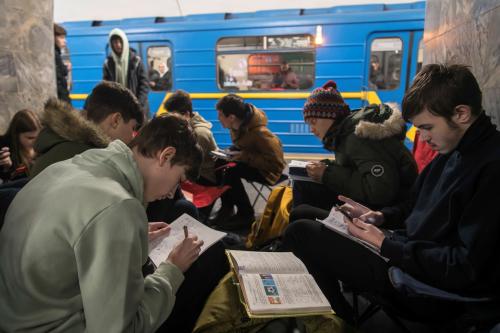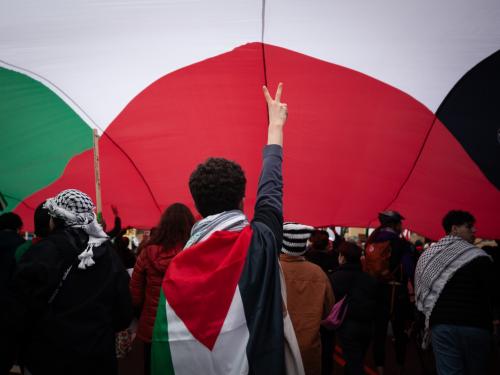Although compromise may be a dirty word in Washington these days, I would like to propose one for the question of how the United States should support Ukraine going forward.
The essence of the compromise would not be simply to split the difference on funding for Kyiv — somewhere between the $60 billion that President Joe Biden wants (on top of the more than $70 billion from the United States to date over the last two years) and the zero preferred by much of the GOP in the House of Representatives. Rather, it would attempt to take the best idea from each side and build a new policy approach on top of that foundation.
Biden’s best idea, and the core of his strategy since February 2022, has been to generously help Ukraine by providing money, weaponry, and intelligence support. U.S. allies have been even more collectively generous, as our Brookings Ukraine Index underscores, but U.S. leadership has been crucial to keeping Ukraine afloat. GOP opponents’ best idea regarding further aid to Ukraine has been to question the open-ended U.S. commitment to a faraway war that appears mostly stalemated — as Ukraine’s top general himself has recently conceded.
A timeline for Ukraine
The United States should fund the Ukraine effort at Biden’s requested level of just over $60 billion and provide virtually all the types of weaponry Ukraine may request over the next 18 months, in the hope that Ukraine can break the stalemate sometime in 2024 or early 2025. But by the winter/spring of 2025, a newly elected American president should ask his or her national security team to conduct a thorough review of Ukraine policy — and if the war still remains largely stalemated at that point, the United States should seriously consider a Plan B while encouraging its allies and President Volodymyr Zelenskyy of Ukraine to do the same.
Giving Ukraine another 18 months or so to attempt to liberate the 17% of its territory that Russia still occupies — as well as the Ukrainian citizens who now live in those areas under Russian rule — makes sense on multiple grounds. To start, it upholds the principle that what Russian President Vladimir Putin has wrought in Ukraine is not only a humanitarian tragedy but a threat to Europe writ large. That is because successful Russian aggression in Ukraine could tempt Putin to attack other countries, such as those parts of NATO members Estonia and Latvia where Russian speakers predominate.
Remaining resolute would also recognize the fact that Ukraine has not yet even received all the types of weapons it has requested, and that even when in possession of modern weaponry, it has barely had time to learn how to use it. Notably, a typical U.S. combat formation trains over a two-year cycle to ensure that its newest troops are up to snuff and that everyone can fight as a team. This policy approach also acknowledges the reality that wars do not proceed along linear trajectories.
Often in U.S. history, for example, wars reached their turning points only after two to three years of fighting: think Vicksburg and Gettysburg in July of 1863 (27 months after the outbreak of the Civil War); France in the summer of 1918 (four years after World War I began and 15 to 18 months after the United States joined the fray); or the “Battle of the Atlantic” and Italy in 1943 in World War II (again, four years after the war began, and almost a year and a half after the U.S. entry).
At the same time, a U.S. policy that planned on a major review after 18 months would merely recognize that any newly elected president would inevitably be expected to direct a review of a policy as important as that for Ukraine. Furthermore, it would also provide a more satisfying answer to the issue of expected war duration than Biden’s slogan that we will support Ukraine “for as long as it takes.” Surely, reinforcing stalemate indefinitely, at huge cost in blood, cannot be a basis for long-term U.S. policy, if that is where we still find ourselves in early 2025. By that point, the deadlock might have lasted more than two years.
The need for a Plan B
Moreover, there is a Plan B that while being far from optimal is acceptable for core U.S. and NATO interests — and for most of Ukraine’s interests as well. It is not perfect, but neither is today’s world in general. At some point, it would become preferable to open-ended conflict of indeterminate duration.
The Plan B would help ensure that Ukraine can defend the territory it controls, help it recover economically, and anchor it to the West in economic and security terms. The plan would not seek to liberate militarily that part of Ukraine held by Russia. Rather, it would hope to regain much or all of that land someday through a long-term diplomatic process undergirded by strategic patience as well as international economic pressure on Russia.
To achieve that first goal, the policy would provide ample defensive weaponry as well as air and missile defense technology. But it would dramatically scale back the provision of weapons designed to liberate territory.
To achieve the second goal, the United States and its partners could develop a Marshall Plan concept for Ukraine, perhaps funded partly by seized Russian assets and possibly undergirded by future European Union membership for Ukraine.
To achieve the last goal, while some would favor NATO membership for Ukraine, that prospect seems unlikely. Georgetown Professor Lise Howard and I have proposed an Atlantic-Asian Security Community (possibly with only 10 members or so, including the United States, major European powers, and Ukraine — and perhaps someday, even a post-Putin Russia) that would deploy American and other Western trainers on Ukrainian soil in an official capacity, largely to create a tripwire of sorts against possible future Russian aggression.
Other security architectures might be considered too, but all should be much meatier than the 1994 Budapest Memorandum that supposedly guaranteed Ukraine’s future security yet failed miserably to do so.
There would be downsides to this backup plan. It would allow Putin, at least for the time being, to retain hold of some of the fruits of his aggression, and thereby weaken international norms against interstate aggression while leaving millions of Ukrainians living under Russian control. But it would stabilize and solidify the security of most of Ukraine and therefore almost all of Europe.
On balance, it is too soon to try to adopt this policy — while trying to persuade Ukraine not to fight to reclaim territory it rightly considers its own. But it should start to be part of the conversation. While the proposal might give Putin some succor, and some hope that he could outwait the West, his forces would still need to hold their ground on the battlefield for at least another year and a half before any such new policy might then be implemented. In short, it gives Ukraine a fair chance to take back what has been stolen from it, without committing to a new forever war that the world and this country cannot afford indefinitely.







Commentary
A possible compromise on Ukraine
November 9, 2023